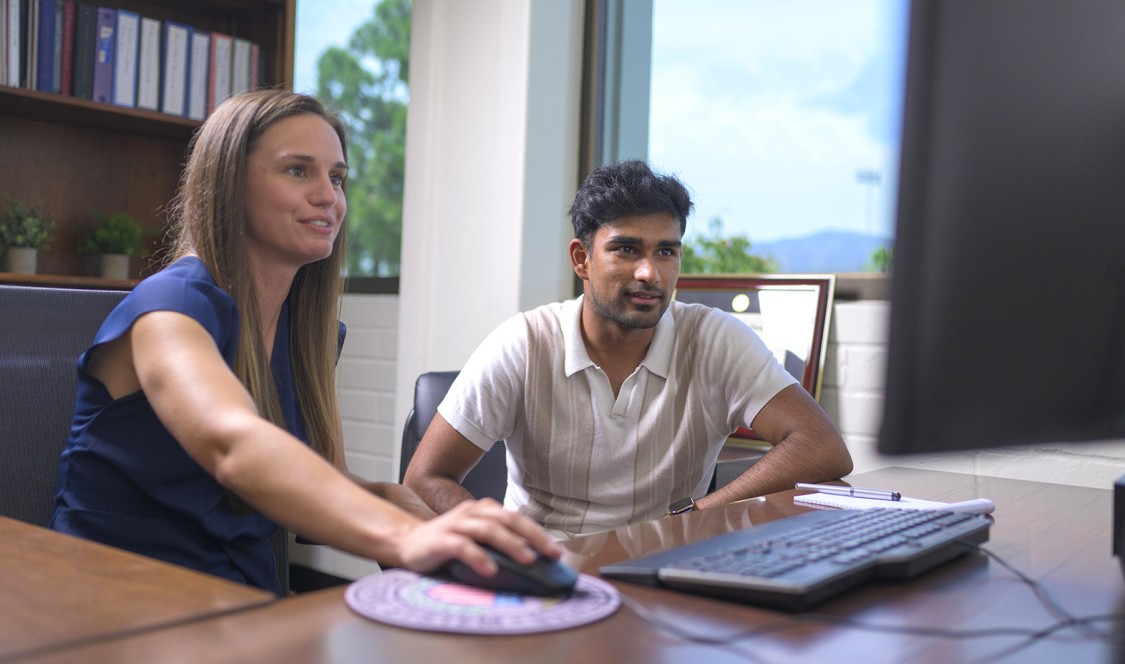Someswar Amujala ’23 still can’t believe that his name pops up alongside CMC Prof. Angela Vossmeyer when he types his name into Google Scholar. The senior CMC student and economics professor are co-authors of the published research paper, “Digitization and data frames for card index records,” in the journal, Explorations in Economic History.
Co-authoring a research paper as an undergraduate is a rare feat, but one that Vossmeyer encouraged, after recognizing Amujala’s data analysis talents.
“Professor Vossmeyer is always very good at thinking about what I've done, building upon those skills, and really expanding my knowledge,” said Amujala, an economics and data science major, and one of Vossmeyer’s research assistants.
Amujala’s ongoing collaboration with Vossmeyer, is just one example among many graduate-level research opportunities provided by CMC where students work alongside professors on a range of projects that span all disciplines.
“One of the hallmarks of the liberal arts education at CMC are these unparalleled opportunities for our undergraduates to conduct high-level research with our distinguished faculty,” said Heather Antecol, Boswell Professor of Economics and CMC’s Vice President for Academic Affairs and Dean of the Faculty. “In my time here as a faculty member, it has been a joy to work with such engaged and inspiring students, and some of the publications I’m proudest of are the ones I co-authored with students.”
Amujala and Vossmeyer’s paper develops a research methodology for “converting historical records into usable data frames for future statistical and textual analyses,” Vossmeyer said.
In other words, “You can load in suitable historical records and just run it,” she added. “It's quite generalizable.”
The methodological tool was developed out of necessity, as Vossmeyer’s research on financial crises relies on archival records such as U.S. Treasury reports from the World War I and World War II eras, and—in this case—more than 22,000 images of index cards collected from banks across the U.S. that received support from the Reconstruction Finance Corporation during the Great Depression.
After acquiring the images of the index cards through the National Archives, Vossmeyer hadn’t fully used them yet “because you can imagine the daunting task” of manually poring through thousands of records, some typewritten and others handwritten, full of typos and other idiosyncrasies inherent to the pre-computer era.
But Vossmeyer —who teaches econometrics and serves as an advisor to the data science capstone teams at CMC— knew that different machine learning techniques and natural language processing tools had improved, and that “there was a way that this could be tackled programmatically, as opposed to manually.”
And she knew Amujala was up for the task.
The Financial Economics Institute (FEI) originally paired Amujala, with Vossmeyer when he was a first-year student. Impressed with his skills, she gave him increasingly challenging coding tasks, which he easily handled, even earning a reference in “Stock Volatility and the War Puzzle,” a paper co-authored by Vossmeyer, published by the National Bureau of Economic Research.
Based upon his accomplishments, Vossmeyer eventually asked if Amujala could develop and train the machine learning and natural language processing tools on another project, with the goal of determining which banks were bailed out in the early 1930s by the U.S. government during the financial collapse.
“I started to kind of just hack away,” Amujala explained. “I think it's always a little easier to break up the problem and do it step-by-step.”
Amujala, whose career sights are on product management, began working on the project during the spring of his sophomore year, and finished by the following fall, “just working on this one problem. It was very tricky,” he said.
Before their work was complete, Vossmeyer received a notification from Northwestern University’s Kellogg School of Management seeking submissions to its “Methodological Advances in the Extraction and Analysis of Historical Data” conference. Vossmeyer leaped at the opportunity, assembling a proposal “before we even had a fully functioning methodology because we knew we could get there,” she said.
And get there they did— albeit virtually. Approximately 100 researchers attended their conference presentation, spanning the worlds of academics, archivists, and tech companies—basically, any researchers “who have hardcopy documents that need to be digitized,” Vossmeyer said.
Garnering positive feedback on their research at the conference, Vossmeyer said, compelled her, along with Amujala and their co-author, Sanjiv R. Das, a professor of Finance and Business Analytics at Santa Clara University, to submit their research for publication in Explorations in Economic History.
Now that it’s out in the world, Amujala is proud that their work is having an impact. (To download the code, visit here).
“Since this paper is really focused more on the methods of our work, rather than the actual end output, this means other people can look at how we did the research, our methods, and different data analysis tools, to replicate that on different versions of their own problems,” he said.
Vossmeyer agreed. “It’s gratifying to package a research project that you know is helping other people,” she said.
Up next, as graduation approaches, Vossmeyer is currently serving as Amujala’s senior thesis adviser. His project, which focuses on Paycheck Protection Program (PPP) loans and their effects on real estate are well on its way.
Valuable learning experiences such as these are made possible at CMC, in part, by the generous support of donors and philanthropists. Through the Campaign for CMC: Responsible Leadership and the specific pillar of honoring our leadership mission, we will ensure that the College continues to deliver on its liberal arts and leadership mission.

